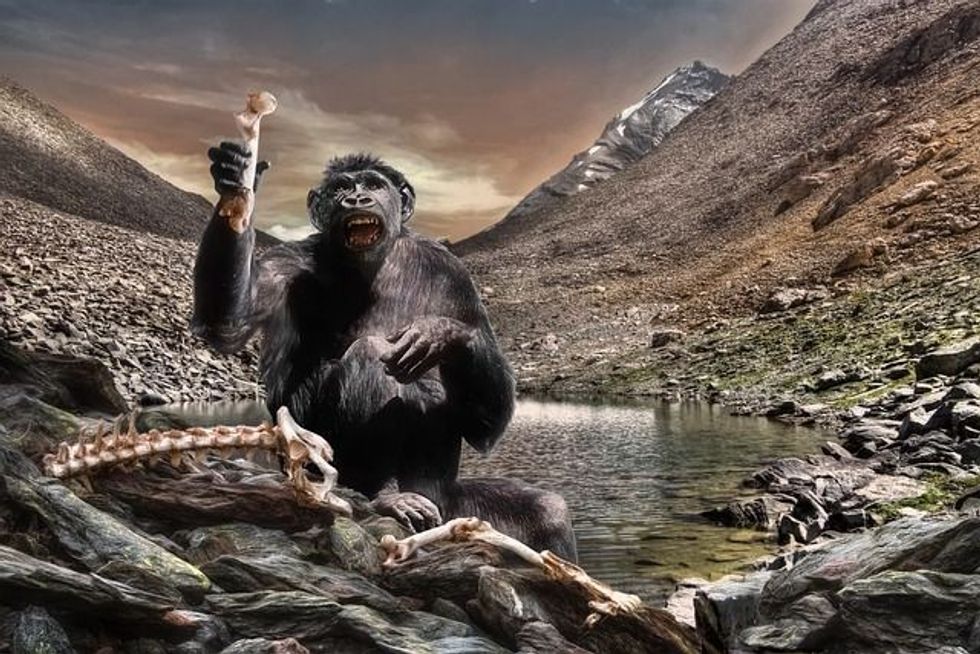Australopithecus Afarensis Facts: Learn About This Extinct Species

The origin of early humans dates back to seven million years ago!
The evolution of early hominin into modern humans is a very lengthy but interesting process. Modern humans and modern apes have a common ancestor.
Modern humans are the result of adaptation and evolution from our early ancestors. Our early ancestors were not quite the same as us, and it took millions of years for the process of change by which modern humans evolved.
Humans are primates, a type of ape species who shared a common ancestor alongside chimpanzees, gorillas, bonobos, and orangutans. Human evolution is characterized by several physiological, morphological, behavioral, developmental, and environmental changes.
Scientific evidence reveals that modern human origins first emerged in East Africa. The fossils of modern humans dated about three million years were first uncovered here.
Scientists have extensively studied and named this species Australopithecus afarensis because they were considered one of the first of many hominid species discovered in Africa, and the best-described fossils in the hominin fossil record.
The two ancestor species Au. afarensis and Au. anamensis were overlapped in geographic space and time. Some paleoanthropologists (researchers who study human evolution) believed that the genus 'Homo' which is represented by species called Homo sapiens, originated from Au.
afarensis. Over time, other paleoanthropologists have made Africanus a side branch and replaced their taxonomic scenarios from Au. africanus to Au. afarensis as our early ancestors.
Keep scrolling to read more about one of our early ancestors, Australopithecus afarensis!
Discovery
Australopithecus afarensis, the best-known extinct species, is also known as the 'southern ape from afar.' These Au. afarensis species are believed to be the ancestors of modern humans, who lived 3.9 to 2.9 million years back in the Pliocene to Early Pleistocene period of Africa.
The first fossils of small-brained and small-bodied hominin specimens were discovered in the 1930s, but between 1972 - 77 major fossils of Au. afarensis was unearthed in Hadar, in the Afar Depression of Ethiopia by the IARE (International Afar Research Expedition), led by anthropologists Donald Johanson, Maurice Taieb, and Yves Coppens.
They found a series of fossils at various sites in north-central, southern, and eastern Africa.
In 1973, the International Afar Research Expedition team discovered the a knee joint (AL 129-1) that showed the earliest example of bipedalism at that time.
In 1974, Johanson and Tom Gray unearthed the extremely well-known skeleton (AL 288–1), commonly referred to as 'Lucy.'
In 1975, the International Afar Research Expedition recovered (AL 333) 216 specimens of thirteen individuals referred to as 'the First Family' though they were not necessarily connected.
In 1976, British palaeoanthropologist Mary Leakey and her colleagues recovered a notable fossil trackway in Laetoli, Tanzania. These Laetoli remains were evidence of being transitional fossils and were preliminarily classified as Homo species, that have Australopithecus-like attributes.
Au. afarensis specimens from the Afar Region, East Africa, have also been recorded in Laetoli, Lothagam, Belohdelie, in Kenya at Koobi Fora, Woranso-Mille, Ledi-Geraru, Maka, and at Fejejin in Ethiopia.
In 2000, AL 822–1, the first fairly complete skull, was discovered by Dato Adan, and dates to approximately 3.1 million years ago.
The partial skeleton of a three-year-old infant(DIK-1-1) was discovered at Dikika at a site in the Dikika region of Ethiopia by a team of researchers led by Leakey Foundation grantee Zeresenay Alemseged in Leipzig, Germany. The skeletal remains of the child dated nearly 3.3 million years old.
In 2005, AL 438–1, an adult specimen with both skull and body elements was unearthed in Hadar.
In 2015, the partial skeleton of an adult (KSD-VP-1/1) was recovered at Woranso-Mille.
The famous trackway of Laetoli footprints discovered by Mary Leakey in the excavations in northeastern Tanzania, which is about 25 miles (40 km) from Olduvai Gorge, was believed to have been made by Au. afarensis individuals walking side-by-side.
The Au. afarensis fossils were commonly discovered in Africa; therefore, the remains were temporarily classified as Australopithecus aff. Africanus, but in 1948, Edwin Hennig, a German paleontologist, classified these remains into a new genus, 'Praeanthropus,' but failed to give a species name.
Later in 1950, German anthropologist Hans Weinert proposed a jawbone found near Laetoli from the headwaters of the Gerusi River as Meganthropus Africanus, but that too was failed. In 1955, the combination Praeanthropus Africanus was proposed by M.S. Şenyürek.
Important Australopithecus Afarensis Fossils
Australopithecus afarensis belong to the genus Australopithecus, a group of extinct primates that are closely related to modern humans. They were one of the best-known, long-lived early human species.
According to the fossils discovered, Au. afarensis species lived between 3.7 to 3.0 million years ago, but were not the only species at that time. Paleoanthropologists in Africa uncovered more than 300 individuals' remains.
Famous paleoanthropologists categorized Au. afarensis, a hominid species with a slender form of an Australopith.
The most significant and well-preserved fossil was the skeleton of a female referred to as 'Lucy' (AL 288-1) unearthed at the site of Hadar in the Afar Depression of Ethiopia.
The discovery of 'Lucy' in 1974 by Donald Johanson's crew increased the momentum in East Africa to find more specimens of human origins.
Lucy's skeleton was about 40 percent complete and was one of the six most complete fossilized hominin skeletons dating 100 thousand years.
In 1975, 'The First Family' (AL 333), a group of thirteen individuals Au. afarensis fossils, including nine adults and four children, were the important discoveries at Hadar. Researchers speculated that they might represent a social group that died together. However, recent examinations of the site suggest differently.
The recent discovery of the oldest hominin fossil, 'Dikika Baby,' dated 3.3 million years ago, has provided great information about the development of early hominins. The Dikika fossil was named DIK 1-1 and nicknamed 'Lucy's baby' or 'Selam.'
Dikika means 'nipple' in the Afar language, named after the nipple-shaped hill at her discovery site. This specimen consists of a preserved skull, including the jaw and teeth, which provided scientists with detailed knowledge of tooth microstructure and development in a hominin juvenile.
The best-known Laetoli trackway consists of 70 tracks, and a newly added 14 more were attributed to Au. afarensis species provides evidence that the early human's habitual bipedalism began early in the human lineage and the species' presence in a more open environment. The hominins formed the footprints when they walked through wet ash erupted from a nearby volcano.
In 1978, Tim D. White, Johanson, and Coppens classified these collections of fossils from both Laetoli and Hadar into a single new species, Au. afarensis. The palaeoanthropologists considered the wide range of variation due to sexual dimorphism.
A frontal bone fragment BEL-VP-1/1 dating to 3.9 million years ago was discovered in the Middle Awash, Afar Region, Ethiopia. Based on age, it has been assigned to Au. anamensis, but it exhibits a form of postorbital constriction, which may be assignable to Au. afarensis.
This evidence suggests that Au. anamensis and Au. afarensis coexisted for at least 100,000 years.
The Au. afarensis species may have prefered to live in a mixed woodland environment, moving between forested areas and trees efficiently.
They are considered to have been collecting plant foods and occasionally hunting animals. With the recovery of stone tools at the Ethiopia site and cut marks on the bones of large animals, it was evident that Australopiths used tools.
Physical Characteristics
An expedition led by American palaeoanthropologist Donald Johanson, French geologist Maurice Taieb, and Breton anthropologist Yves Coppens, unearthed major collections in Hadar, Ethiopia, from 1972 to 1977. These recovered specimens were well preserved, cleaned, reassembled, and reconstructed. The fossil evidence revealed many skeletal aspects that had been associated with the specimens.
Au. afarensis had a lot of common features with great apes, but like we humans, they walked upright on two feet! They also had long, ape-like arms with long, curved fingers that were perfect for hanging out and swinging from branches of the trees like other African apes.
The features of Au. afarensis, derived by reconstructing the fossils, had a mixture of ape and human-like body features. They had tall faces, small bodies, thick enamel on their teeth, reduced canines, intermediate molars, delicate brow ridges, protruding jaws, small brains, an upright stance, and bipedalism (could walk on two limbs).
Lucy was one of the most complete but smaller hominin skeletons. However, she has been the center of most studies since her discovery. The illustration of the fossil 'Lucy,' compared with a modern human female, shows that Lucy was only about 3.8 feet (116 cms) tall.
It also proved that the Au. afarensis species are like chimpanzees but have some Homo sapiens characteristics.
This species' body size, skull shape, and brain size are similar to a chimpanzee. Lucy's heavily built chimpanzee-like arm bones indicated that the Au. afarensis spent considerable time climbing on trees.
The incisors and canine teeth of Au. afarensis are reduced in size compared to earlier hominins. Sharp, projecting upper canine teeth against the lower third premolars are absent. They consumed a wide range of foods, including leaves, fruits, and meat. This varied diet might have been flexible for their life in various environments.
Unlike chimpanzees, their femur and pelvis articulation resemble humans, proving that this species walked upright on two legs. Based on the Laetoli footprints, it is evident that the feet were slightly inverted, which would have assisted in climbing.
The Males were taller than females due to sexual dimorphism. The males were 4.11 feet(125 cms) and females 3.5 feet( 107 cm) tall, respectively, with weights ranging from 64-99 lb (29-45 kg).
Lucy's estimated brain volume was an average of 365–417 cc, and that of the infant (DIK-1-1) specimen was 273–315 cc. Based on these measurements, Au. afarensis brain growth rate was closer to the modern humans but had no human-like brain configuration and were organized like ape brains.

In 1974, the discovery of Australopithecus afarensis fossils in East Africa, who lived about 3.9 to 2.7 million years ago, narrated a game-changing story about modern human origins. Au. afarensis are one of the better known species because many fossil fragments of more than 300 individuals of this species have been found so far in Ethiopia, Tanzania, and Kenya.
A well-established female specimen 'Lucy' became famous worldwide as it revealed many secrets to scientists about our early ancestors, though only 40 percent of her skeleton was preserved. Au.
afarensis had a prognathic face, a primitive skull, and a small brain. Their teeth were large and had a U-shaped dental arcade. Their limbs were competent of a precision grip.
FAQs
What are three facts about Australopithecus?
Three facts about Australopithecus are:
As modern human beings, they are bi-pedal.
They had small brains like the apes of their times
They had small canine teeth
What is unique about the Australopithecus?
Paleoanthropologists believed the Australopithecus was one of the earliest ancestors of the modern human, and their fossils are very important in the study of human evolution. Skeletal features of Australopithecus show that these species include many ape-like features but proved to have unique features like bipedal locomotion.
Their canine teeth are also small like humans, have straight bodies, and walk upright on two legs.
Where did Australopithecus afarensis live?
Fossils of this species have been found in Ethiopia, Kenya and Tanzania, countries in the north east of Africa.
How long ago did the Australopithecus Afarensis live?
Australopithecus Afarensis was considered one of the longest-lived early human species. According to the fossils found, this species lived between 3.9 - 2.9 million years back and was known to be survived for about 700,000 years. It means Au. afarensis lived twice as long as our own species, homo sapiens.
Where was Australopithecus Afarensis first found?
In 1974, major collections of fossils of Au. afarensis, one of the oldest known modern human ancestors was first found in Ethiopia, East Africa. The most significant Au. afarensis specimen was nicknamed 'Lucy' by Johanson and Tom Gray after the Beatles' song - Lucy in the Sky with Diamonds, playing on their tape while excavating.
Where did the Australopithecus Afarensis migrate to?
AThe species Au. afarensis footprint fossils have been found at Laetoli in Tanzania preserved under sediment layers of ash, and it is about 1516 miles (2400 km) away from Ethiopia. It proved that they could migrate to locate their food sources because of the changing environment that existed through that period.
How many chromosomes did Australopithecus Afarensis have?
It isn't easy to speculate with accuracy whether Au. afarensis have chromosomes like humans or apes. Usually, humans have 46 chromosomes, whereas gorillas, orangutans, and chimpanzees have 48 chromosomes.
How did it get its name?
The genus name Australopithecus means 'southern ape' and was formally named in 1978, following a wave of the first fossils discovered at Hadar, Ethiopia, and Laetoli, Tanzania in South Africa. The species is named after the Afar Region of Ethiopia, where most of the fossils were recovered.
We Want Your Photos!
More for You
See All
Bachelor of Science specializing in Botany, Master of Science specializing in Clinical Research and Regulatory Affairs

Sridevi ToletyBachelor of Science specializing in Botany, Master of Science specializing in Clinical Research and Regulatory Affairs
With a Master's degree in clinical research from Manipal University and a PG Diploma in journalism from Bharatiya Vidya Bhavan, Sridevi has cultivated her passion for writing across various domains. She has authored a wide range of articles, blogs, travelogues, creative content, and short stories that have been published in leading magazines, newspapers, and websites. Sridevi is fluent in four languages and enjoys spending her spare time with loved ones. Her hobbies include reading, traveling, cooking, painting, and listening to music.
Bachelor of Science specializing in Environmental Science

Lenin KambamBachelor of Science specializing in Environmental Science
With a degree in Environmental Science from the D. M. College of Science, Lenin brings a unique blend of skills to the table. He has a solid background in sales and marketing, as well as extensive experience in the transcription industry spanning over a decade. Lenin is also committed to making a positive impact through his involvement in social and research projects.
Disclaimer
1) Kidadl is independent and to make our service free to you the reader we are supported by advertising. We hope you love our recommendations for products and services! What we suggest is selected independently by the Kidadl team. If you purchase using the Buy Now button we may earn a small commission. This does not influence our choices. Prices are correct and items are available at the time the article was published but we cannot guarantee that on the time of reading. Please note that Kidadl is a participant in the Amazon Services LLC Associates Program, an affiliate advertising program designed to provide a means for sites to earn advertising fees by advertising and linking to Amazon. We also link to other websites, but are not responsible for their content.
2) At Kidadl, we strive to recommend the very best activities and events. We will always aim to give you accurate information at the date of publication - however, information does change, so it’s important you do your own research, double-check and make the decision that is right for your family. We recognise that not all activities and ideas are appropriate for all children and families or in all circumstances. Our recommended activities are based on age but these are a guide. We recommend that these ideas are used as inspiration, that ideas are undertaken with appropriate adult supervision, and that each adult uses their own discretion and knowledge of their children to consider the safety and suitability. Kidadl cannot accept liability for the execution of these ideas, and parental supervision is advised at all times, as safety is paramount. Anyone using the information provided by Kidadl does so at their own risk and we can not accept liability if things go wrong.
3) Because we are an educational resource, we have quotes and facts about a range of historical and modern figures. We do not endorse the actions of or rhetoric of all the people included in these collections, but we think they are important for growing minds to learn about under the guidance of parents or guardians.







